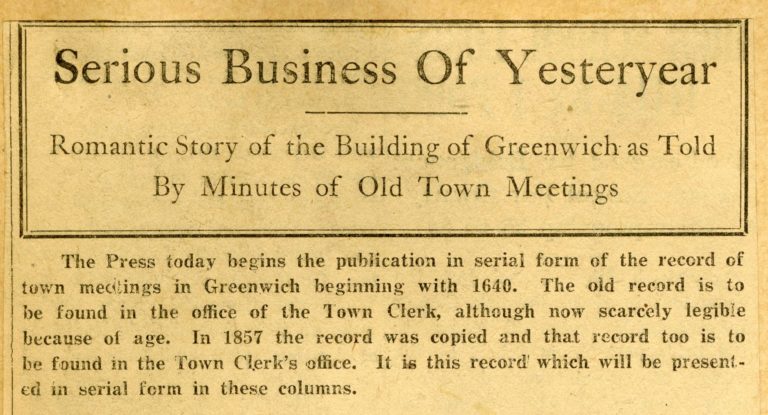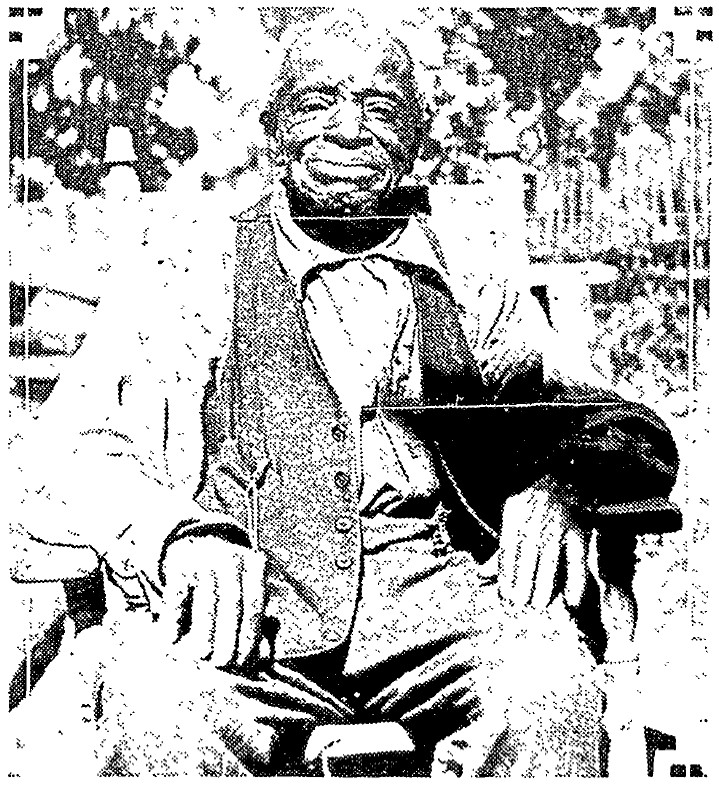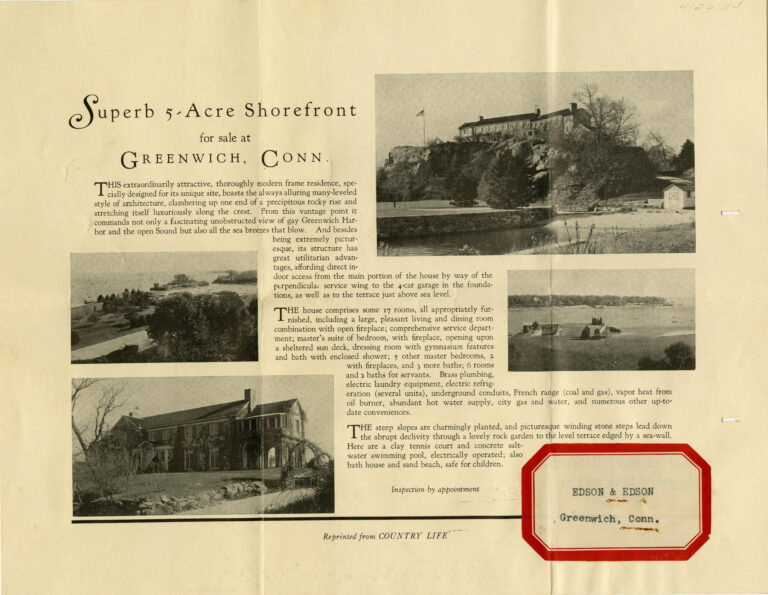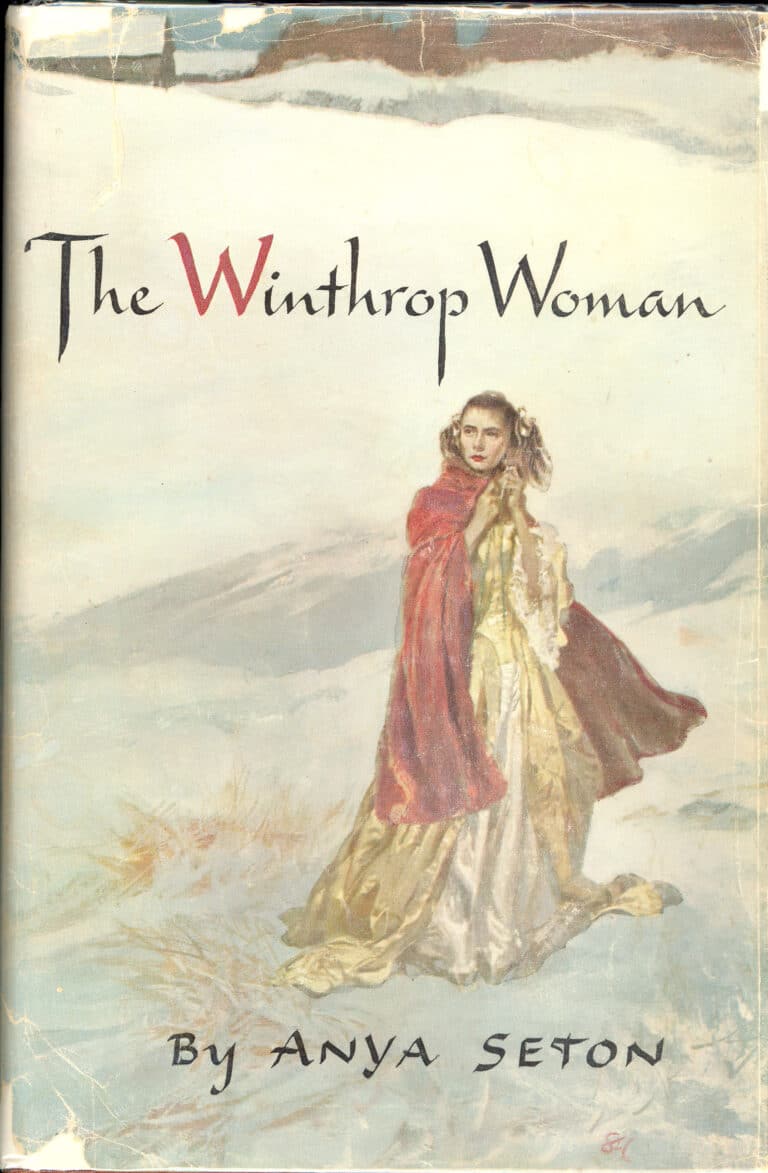The “Romantic Story of the Building of Greenwich” was the brainchild of Norman Talcott, the publisher of The Greenwich Press, a local newspaper. His novel approach was to publish an authorized “copy” of the original minutes of Greenwich Town Meetings dating from 1640 to 1754 in a weekly series which began in the late 1920s to early 1930s to introduce the concept of Representative Town Meetings, the “RTM”, instead of “open” Town Meetings. Although not his intent, this was the first time that the Town’s earliest records had been published for the benefit of the greater public.
The “copy”, which Talcott published of the earliest records preserved at Greenwich Town Hall, had originally been approved as a preservation initiative at a Greenwich Town Meeting in 1857. Talcott’s published series, which had been preserved in a scrapbook, was donated to the Greenwich Historical Society’s Archives in 1988. Now, 162 years after being first copied “by hand” in 1857, the Greenwich Historical Society has initiated a major project to digitize the “copy” of the earliest records of Greenwich Town Meetings, so that the series will be available to the greater public online on the Greenwich Historical Society’s website.
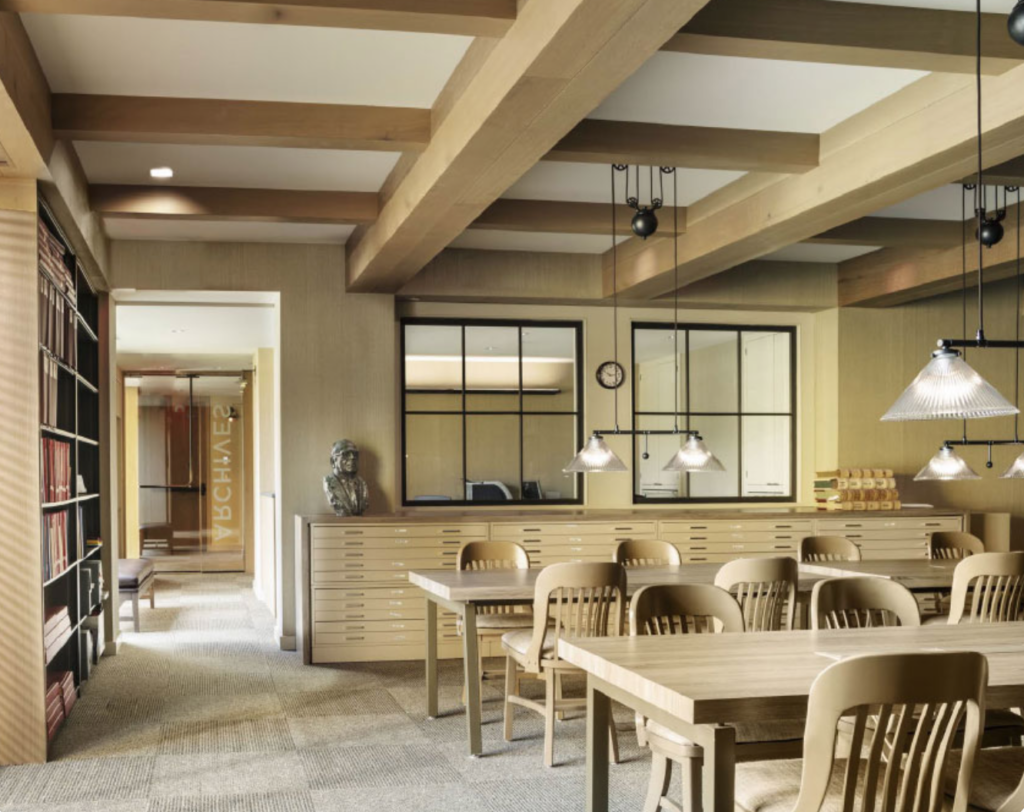
Library and Archives at Greenwich Historical Society. Photograph by Durston Saylor.
Join us as we trace the serendipitous preservation efforts of generations of concerned and dedicated individuals, organizations, residents and donors, who have ensured that irreplaceable 17th and 18th century original source records would not only be preserved at Town Hall, but also be made available to the public.
First, a bit of history about the earliest Greenwich Town Meetings…
The Town of Greenwich was legally established in 1665 in what is today’s Old Greenwich by the authority of the Connecticut General Assembly under the rule of the King of England and a liberal charter secured by Governor John Winthrop, Jr. in 1662 for the Connecticut Colony. Because Government and Church in Connecticut were inseparable until 1818, the functions of the Town of Greenwich Meetings were economic and religious. The townsmen (selectmen) and proprietors were able to allot land divisions, settle land disputes, authorize the collection of taxes to support the ministry, fund and build a State authorized Congregational town house (church), and admit new residents, while designating surveyors, fence-viewers, and other committees for the daily maintenance of the Town.
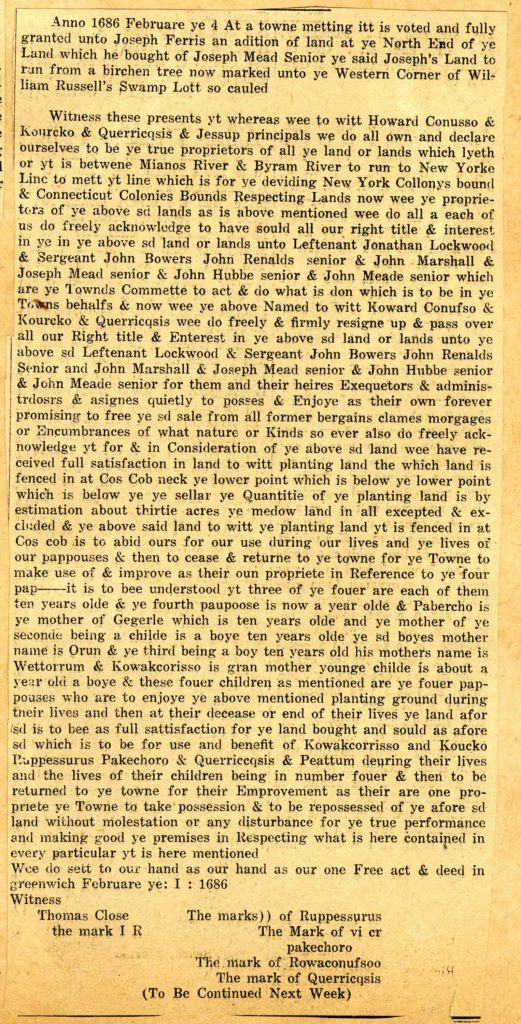
Seemingly mundane, the early minutes of the Town of Greenwich Meetings, however, reveal an incredible everyday record of ordinary people who were making extraordinary decisions during the formative years of the Town of Greenwich. Pictured above, for example, is a digital copy of the 1686 sale of “all ye land or lands which lyeth or yt is betweene the Mianos River & Byram River to run to the New Yorke line” by four Native American “ye true proprietors” (quote from the deed) to seven British proprietors forty years after Greenwich had been founded in 1640. The Native Americans received in exchange thirty acres of fenced-in planting land along the shore of today’s Indian Field Road on Mead Point in Cos Cob. It is in the same area on Mead Point where the sale in the recent past by the late David Ogilvy of a multi-acre former Great Estate, “Kincraig”, broke national real estate records for its exceptionally high sales price.
The Donor
In 1988, Murial Putnam Smith (Mrs. Everett Smith, Jr.) donated the old scrapbook to the newly constructed Archives (1987) at the Greenwich Historical Society. Mrs. Smith was a direct descendant of the American Revolutionary War hero, General Israel Putnam, as well as a member of the Greenwich Chapter of the Daughters of the American Revolution (“D.A.R.”), and a member of the Greenwich Historical Society.
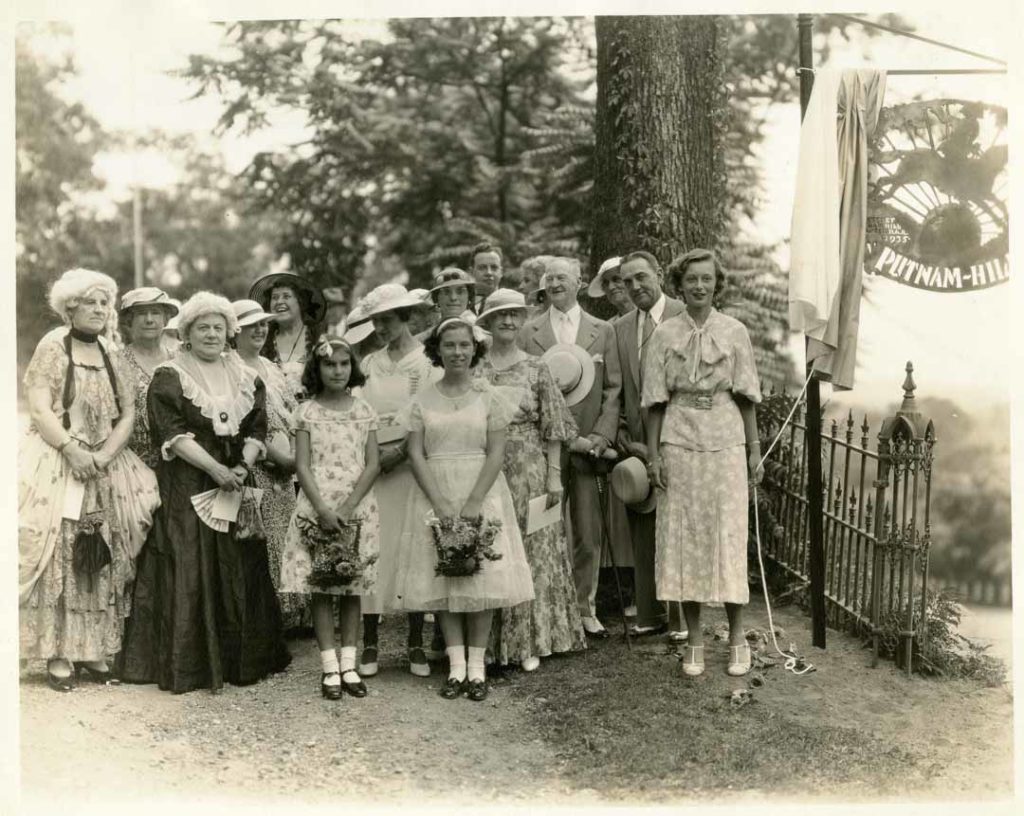
Representative of her family’s long-term commitment to preservation, when the Town of Greenwich celebrated its 375th anniversary in 2015, the kick-off event featured the restoration of a long-lost historic sign at Putnam Hill Park and a re-dedication of the park. To publicize the event, a photograph from the Archives of the D.A.R.’s first dedication in 1935 to celebrate Connecticut’s Tercentenary was used on the “Save the Date” post card (pictured). Murial Smith, then 94 years old, received the post card and told her daughter that she, then fourteen years old, and her mother, who had been chair of the event, were pictured at the unveiling of the sign. Her daughter telephoned the Historical Society and Murial Putnam Smith became the honored guest at the official opening ceremony of the Town’s 375th Anniversary re-dedication held at Putnam Cottage prior to the reenactment of General Israel Putnam’s ride up to Putnam Hill Park.
Mrs. Putnam Smith died three years later on Sept. 27, 2019 at the age of 97. Her obituary noted that she had attended Greenwich Academy, and was graduated from Miss Porter’s School, Sarah Lawrence College, and the New York School of Professional Art.
The Collector
The donor’s father, Eben F. Putnam, was a dedicated preservationist who had begun saving the clippings of the Town Meeting minutes in a scrapbook three years before being elected to the Greenwich Historical Society’s Board of Director’s at their Annual Meeting in 1932. It was one year after the Historical Society had been founded and had located its headquarters in a rented room (pictured) in the then new Perrot Memorial Library in Old Greenwich. The main topic on the Annual Meeting’s agenda was the creation of a committee to convince the Town of Greenwich to undertake measures to preserve the Town’s valuable documents.
Putnam served on that committee and remained on the Historical Society’s Executive Committee as Treasurer until his death in 1953. Eben Putnam and his wife, Frenelia L. Putnam, died tragically on a National Airlines flight that crashed into the Gulf of Mexico on February 14th killing all of the passengers. At the time, Putnam was president and director of the Greenwich Gas Company, which he had organized in 1925. He was also the former president and general manager of the Greenwich Water Company, the New Canaan Water Company, and had also served on numerous boards, including as Vice President of the Greenwich Tercentenary Celebration’s Executive Board in 1940.
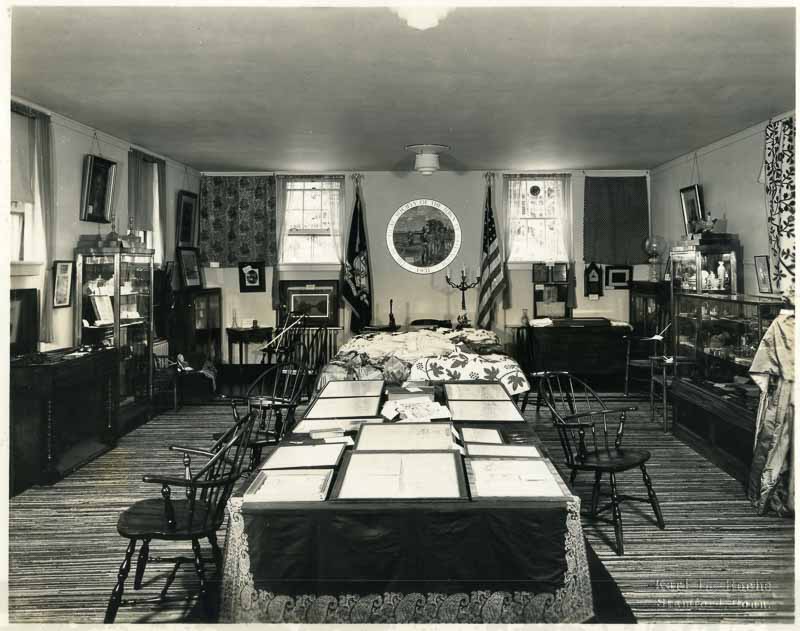
The scrapbook donated by Murial Smith contained hundreds of over sixty year-old newspaper clippings her father, Eben F. Putnam, had methodically saved. The clippings featured a series entitled, “Serious Business of Yesteryear: Romantic Story of the Building of Greenwich as Told by Minutes of Old Town Meetings”, which was published weekly between 1928 and 1934 in The Greenwich Press. For this special series, the publisher, Norman Talcott, had reprised transcriptions of two original record books in the Town Clerk’s office known as “Common Place Book I” (1666-1739) and “Common Place Book II” (1671-1754), containing the earliest minutes of Greenwich Town Meetings. On the first page he included the original resolution approved at a Greenwich Town Meeting on October 5, 1857 permitting copies to be made of the records because the original minutes at Town Hall had been deemed “scarcely legible because of age”.
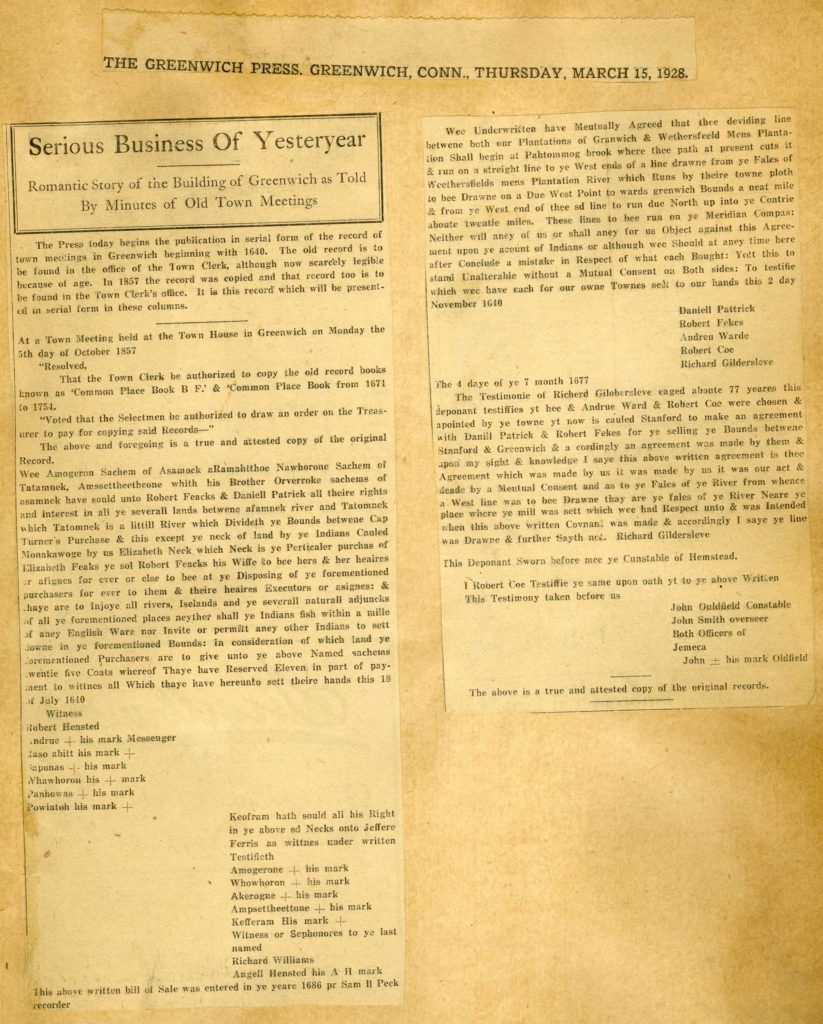
The Publisher
Norman Talcott was a seasoned journalist, editor and owner of The Greenwich Press. He published the minutes of the Town Meetings in a series beginning on March 15, 1928 at the height of the Roaring Twenties. The population of Greenwich by then was 26,000 and editorials in the local newspapers, including The Greenwich Press, had begun to advocate for a Representative Town Meeting (RTM) rather than the all-inclusive Town Meetings, like the heated Greenwich Town Meeting in April of 1928 which 1,000 people attended and overwhelmingly rejected a much needed proposition to reorganize town government and investigate tax matters.
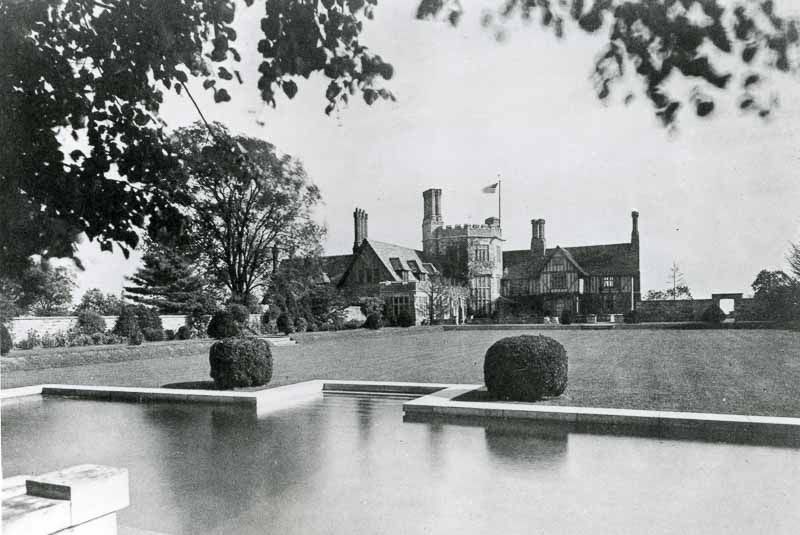
The 1920s brought suburbanization and the demolition of houses, like Weed’s Tavern, which had stood on Putnam Avenue since 1790, to make way for the in-town Chateau Lafayette apartment building. Golf courses were created for leisure recreation and new school buildings for education expansion replaced Victorian houses. In 1926, former Great Estates were transformed into the major subdivisions of Indian Harbor, Deer Park, Khakum Wood (pictured) and Milbrook, to name a few. The first Greenwich Zoning Commission, the first Greenwich Building Department, and the first Zoning Board of Appeals were created between 1925 and 1926 to preserve the rural, formerly pastoral landscapes.
After the first editorials appeared in 1928, it took seven years of Town of Greenwich Meetings for the Greenwich Representative Town Meeting (“RTM”) to be organized under a special act of the Connecticut General Assembly, which abolished open Town Meetings in 1933. Within months of Norman Talcott ceasing publication of the series “Serious Business of Yesteryear”, the first Representative Town Meeting of the Town of Greenwich, the “RTM”, was held on October 16, 1933. It was also the first in the State of Connecticut.
The Preservationists

Fast forward to 1992, by then the former Greenwich High School building built in 1926 (pictured above) had become Town Hall (dedicated June 10, 1980) and Carmella Budkins had been elected Town Clerk. She officially formed the “Town of Greenwich Preservation Committee” with the goal of planning and implementing a conservation program for the Town’s manuscript record books, especially those dating from the mid-seventeenth century to about 1850. Since then, beginning with the “Common Place Books”, the original Town’s record books have been conserved to the highest archival standards by the Document Conservation Center and preserved in the vault in Town Hall. The “Commonplace Books” of the first Town meetings from 1640 to 1809 and the Land Records from 1724 to 1831 have also been preserved on microfilm. Two copies of the microfilm are preserved in the vault at Town Hall and one set is available for researchers to use in the newly enlarged Archives, Library and Reading Room at the Greenwich Historical Society.
This past year, the Greenwich Historical Society initiated the project to digitize the readable text of the “Common Place” Books published in The Greenwich Press, which had been preserved by Eben Putnam in a scrapbook and donated to the Archives by his daughter, Murial Putnam Smith, in 1988. The records will now be available on the Greenwich Historical Society’s website so that the wealth of information about the Town’s earliest development and the people in whose footsteps we follow will also be preserved in a digital copy that can be accessed online by teachers, students of history, genealogists, and families for years to come. Click here to read more on “Common Place” Books.
